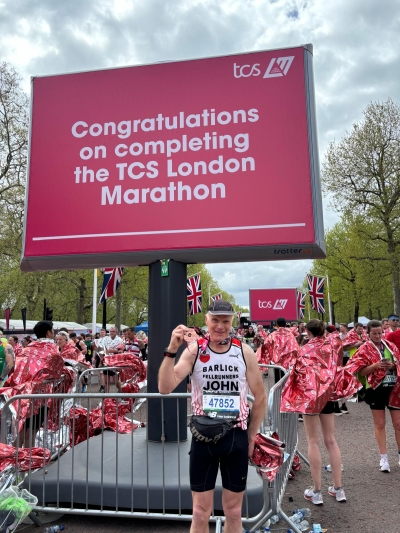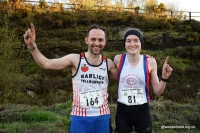- Seniors
- For members over the age of 18
- £10/year
- For runners of all abilities over the age of 18
- For runners participating in all disciplines of running, fell, cross country and road running
- Regular training and coaching sessions provided
- Apply
- Juniors
- For members under the age of 18
- FREE
- For runners of all abilities under the age of 18.
- Regular (weekly) training sessions led by experienced runners/coaches
- Advice about how to train properly so juniors can develop as athletes
- Apply
- Non-runners
- For non-running members
- £5/year
- For supporters of the club and club members
- Support the club and all the senior and junior runners
- Apply
Pub Run - Wednesday 24 April 2024
Written by GrahamThis will from from The Alma Inn. Be there for a 7:00 pm start.
Blackpool Half Marathon - 21 April 2024
Written by Graham93 Sarah Allen 2:07:17
95 Michaela McKenzie 2:07:38
London Marathon - 21 April 2024
Written by GrahamJohn Boothman completed his second marathon in a week and Raymond Banks put in a great performance in the V70-74 category.
This is John's account of his day.
It was very cold pre race but thankfully dry. The cool temperature was a bonus once we got running. The pace was perfect and I was really enjoying the support along the route. As I rounded the corner to go over Tower Bridge, the crowd was massive and very loud. Right in the middle of the bridge, with no warning, I felt a painful twang in my right calf and was immediately in pain and limping badly. I stopped and took some pain killers and applied some ibuprofen gel then set off at a very steady hop. The pain subsided once the meds took effect but I limped the rest of the way to the finish. Another amazing experience and great to have family support along the route although I think they worked harder than me battling the crowds. Then straight back to change and off to see ABBA Vantage which was amazing, then out for a meal. A full on day with family and friends. What could be better?
16869 John Boothman 3:50:23
25970 Raymond Banks 4:16:19
Skipton Park Run - 20 April 2024
Written by Graham1 Jimmy Craig 16:24 PB
24 Hannah Newbold 22:28
45 Anthony Brown 24:31
50 Dave Halliday 24:43
105 Stephen Jackson 28:11
Burnley Park Run - 20 April 2024
Written by Graham225 Richard Shilton 29:44 PB
Pendle Park Run - 20 April 2024
Written by Graham48 Robert Cranham 43:16
Clowbridge 5K - 18 April 2024
Written by GrahamJust two Barlick women out this week with Lucy Brown taking the honours in the ladies race.
1 Lucy Brown 23:11 (1st W40)
4 Paula Cullen 24:39 (1st W45)
Bunny RunnThree - 16 April 2024
Written by GrahamIt was much better weather conditions for this race and another top performance from Jimmy Craig saw him hold off challenges from Tom Adams and Michael Malyon to take his second Bunny Run victory.
This win makes Jimmy the Series Champion in front of Mitchell Boocock of Pudsey & Bramley and Alexander Wolfenden of Ilkley Harriers.
1 Jimmy Craig 16:31
16 Nick Treitl 18:06
30 David Poole 19:20
58 Andrew Smith 21:29
80 Hannah Newbold 22:37
94 Lucy Brown 23:36
Pub Run - 17 April 2024
Written by GrahamThis will be from the Anchor at Salterforth. Be there for 7:00 pm. This is a social event and unattached runners or runners from other clubs are welcome to join us.
Boston Marathon - 15 April 2024
Written by GrahamJohn Boothman flew to the United States especially for this race and in his own words, this is how the race panned out.
I think that it is nothing more than a bad reaction to a meal we had the night before and was made worse by the exertion and heat. I had drunk lots of water along the route. Still feeling a bit nauseous today but will be fine soon.
16704 John Boothman Half 1:45:51 Finish 4:03:09
More...
Skipton Park Run - 13 April 2024
Written by Graham12 Andy Berry 19:47
14 Lucas Payne 20:08
29 Helen Harrison 21:46
39 Lucy Brown 23:00 PB
63 Nick Kendall 25:19
Pendle Park Run -13 April 2024
Written by Graham13 Sean Fitzpatrick 24:09
14 Peer Jackson 24:44
Burnley Park Run - 13 April 2024
Written by Graham38 Raymond Banks 22:49
95 Lisa Gee 25:59 PB
1465 Stephen Jackson 27:43
226 Richard Shilton 30:37
Woodhouse Moor Park Run - 13 April 2024
Written by Graham26 Robert Cranham 19:55
About us
The main aims of the club are to increase the participation of running in Barnoldswick and to keep organised running as accessible as possible.

